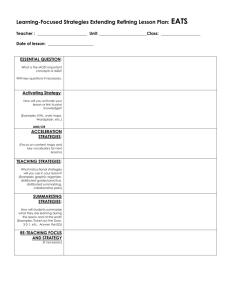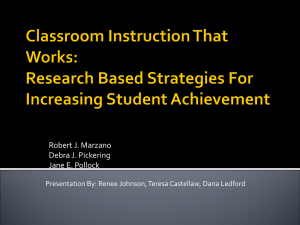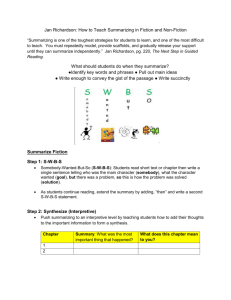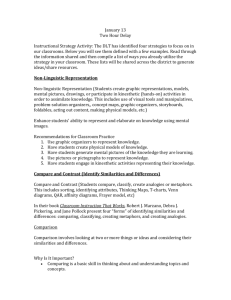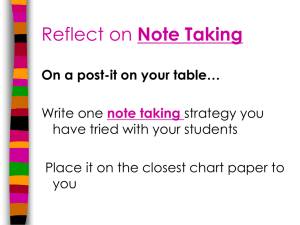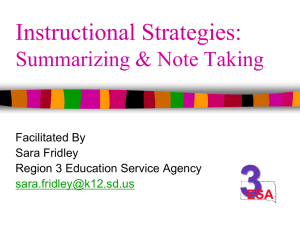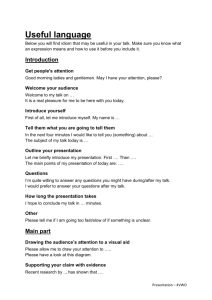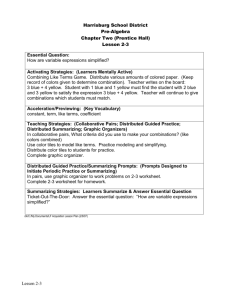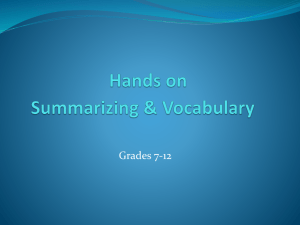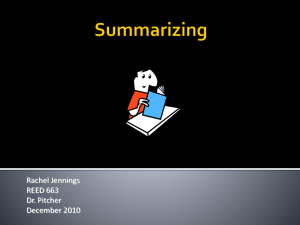Unit - Ware County School System
advertisement
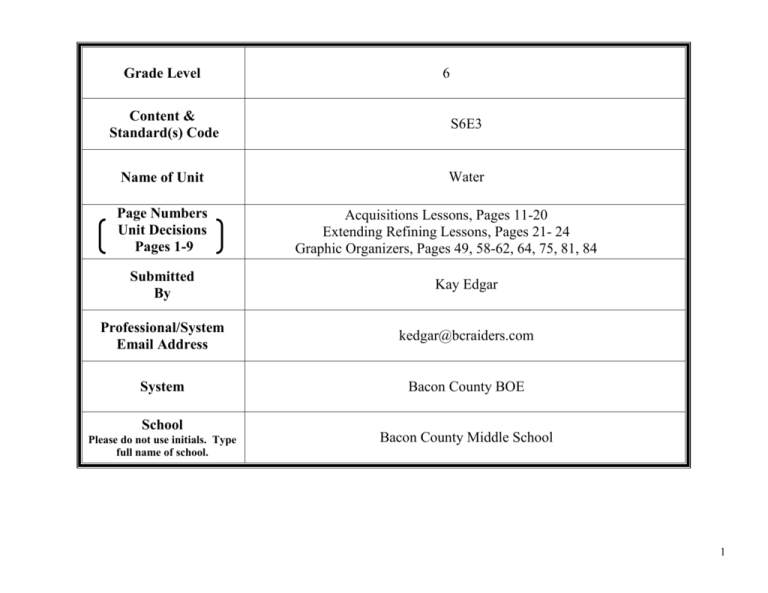
Grade Level
6
Content &
Standard(s) Code
S6E3
Name of Unit
Water
Page Numbers
Unit Decisions
Pages 1-9
Acquisitions Lessons, Pages 11-20
Extending Refining Lessons, Pages 21- 24
Graphic Organizers, Pages 49, 58-62, 64, 75, 81, 84
Submitted
By
Kay Edgar
Professional/System
Email Address
kedgar@bcraiders.com
System
Bacon County BOE
School
Please do not use initials. Type
full name of school.
Bacon County Middle School
1
Created
by: Kay Edgar
Decision Two: The performance or product project
that will be the culminating activity of the unit
Students will complete a lab activity, called “Shifting Sands”.
Note:
Decisio
One is
the
Conten
Map
Fish
Bone,
page 38
Students’ Assignment Page for the Culminating Activity
Essential Question (EQ) of the Culminating Activity: (Once the EQ is stated, place the answer/idea to the EQ
within parentheses.)
How does water affect Earth’s processes?
Paragraph Description of the Culminating Activity:
Shifting Sands is a thought provoking activity. Students will analyze various samples of sand, isolating and
identifying different components of beach, river, and stream samples. Then students will predict where they think
each sample came from on a map. This activity allows students to see how water through currents and waves affects
sediments.
Steps/Task Analysis of Culminating Activity (Include an example Graphic Organizer (GO). See page 27 for
GO index. Cite GO title and page # in text box below.)
2
1.
2.
3.
4.
5.
Sands of Time
After being divided into groups and assigned tasks, students will be given 6 sand samples, a magnifying glass,
toothpick, an outline map of Georgia and Florida with the cites of origin marked, an outline map of Georgia tha
shows the rivers as well as the barrier islands, and a key with spaces available and labeled for rock fragments,
mica, shell fragments, and fossil fragments (which are usually black), and sand (small grains of quartz).
Students will then isolate, identify, and place in the appropriate spaces on their key the various fragments in
their samples of sand (Include at least one sample from a riverbank {brown}, one from a barrier island {tan},
one from the east coast of central Florida {beige, mostly sand-quartz and some shell fragments}, and one from
the west coast of central Florida {white & grey, full of shell fragments and fossil fragments}. Each sample
should look very different from the others.).
Then students will predict where they think each sample came from on their map.
The teacher will lead a discussion that directs students to the appropriate point of origin for each sample of
sand.
Finally, students will be asked how the particles were transported, and what processes caused the particles
within the samples to be shaped as they are.
GO-Fishbone-page 38
Decision 3: Culminating Activity/Project Rubric
Scale
Criteria
3
Collaborative Work Skills : Shifting Sands
CATEGORY 4
Quality of
Provides
Work
work of the
highest
quality.
3
Provides
high quality
work.
Problemsolving
Refines
solutions
suggested
by others.
Actively
looks for
and
suggests
solutions to
problems.
2
1
Provides work Provides work
that
that usually
occasionally
needs to be
needs to be
checked/redone
checked/redone by others to
by other group ensure quality.
members to
ensure quality.
Does not
Does not try to
suggest or
solve problems
refine solutions, or help others
but is willing to solve problems.
try out solutions Lets others do
suggested by the work.
4
others.
Focus on the Consistently Focuses on
task
stays
the task
focused on and what
the task
needs to be
and what
done most
needs to be of the time.
done. Very Other group
selfmembers
directed.
can count
on this
person.
Focuses on the
task and what
needs to be
done some of
the time. Other
group members
must
sometimes nag,
prod, and
remind to keep
this person ontask.
Usually
Sometimes
provides
provides useful
useful ideas ideas when
when
participating in
participating the group and
in the group in classroom
and in
discussion. A
classroom satisfactory
discussion. group member
A strong
who does what
group
is required.
Rarely focuses
on the task and
what needs to
be done. Lets
others do the
work.
Contributions Routinely
provides
useful ideas
when
participating
in the group
and in
classroom
discussion.
A definite
leader who
Rarely provides
useful ideas
when
participating in
the group and
in classroom
discussion. May
refuse to
participate.
5
contributes member
a lot of
who tries
effort.
hard!
Working with Almost
Usually
Others
always
listens to,
listens to,
shares,
shares with, with, and
and
supports
supports
the efforts
the efforts of others.
of others.
Does not
Tries to
cause
keep
"waves" in
people
the group.
working well
together.
Often listens to,
shares with,
and supports
the efforts of
others, but
sometimes is
not a good
team member.
Rarely listens
to, shares with,
and supports
the efforts of
others. Often is
not a good
team player.
6
Decision 4: Student Assessments
Plan for how students will indicate learning and understanding of the
concepts in the unit. How will you assess learning?
Possibilities / Options:
• Short answer tests or quizzes
• Student logs or journals as informal writing
• Center / station / lab activities
• Formal writing assignments
• Design and/or construct model / museum / exhibit
• Informal or formal student observations or interviews
7
1.
2.
3.
4.
Students will complete short answer tests or quizzes.
Students will maintain a notebook which contains notes, writing assignments, and lab activities.
The teacher will complete informal observations.
Students will complete the culminating activity.
Decision 5: Launch Activities
Develops student interest and links prior knowledge. Provides the content map and key vocabulary to
students.
8
Students will predict the relative percentages of land and water on Earth. Then students will toss an inflated
globe 100 times. As each student catches the globe, the student will call out “land” or “water” – what the
right thumb is touching. An appointed score keeper will record tally marks for each call. Afterwards,
students will compare the score to both reality and their predictions.
Content Map of Unit
Topic: S6E3 Water
Key Learnings:
The Earth’s water is in constant motion with water moving from place to place and from
phase to phase.
Unit Essential Questions:
What role does water play in Earth’s processes?
Concept:
Surface Water
Lesson Essential Questions:
Where will the water you drink this morning be tomorrow?
Is it possible to cross the Mississippi River in one step?
How much water will a watershed shed if a watershed sheds its wetlands?
If you had a window into the earth so you could see what’s beneath your feet, what would
you see?
Vocabulary:
Condensation, evaporation, drainage basin, watershed, runoff, tributary, brackish water,
underground water, estuary, marine, freshwater, brackish water, salinity, wetland, ground
water, surface water, water table
Concept:
9
Oceans
Lesson Essential Questions:
Why does salinity vary throughout Earth’s oceans?
How does the topography of the Earth’s oceans change?
Vocabulary: density, composition, subsurface topography, shelf, slope, plain, trench, ridge,
sea mount, island, basin, rift, sediment, sounding, sonar, depth, transect, submersible
Concept:
Waves, Currents, Tides
Lesson Essential Questions:
Why does the ocean move?
Vocabulary: trough, crest, wavelength, wave height, energy, conduction, solar heating,
density, currents, gravity, spring tide, neap tide, Coriolis Effect, Gulf Stream, tides, tsunami
Decision 6: Acquisition Lessons
Plan the acquisition lessons you need for your Learning Unit. You must have at
least one lesson for each of your essential questions in your Content Map.
10
See the Acquisition Lessons Templates (pages 11-17) and the
Extending Thinking Lesson Planning Templates (pages 18-24) to complete Decision 6.
Created By:
Kay Edgar
Essential Question:
Activating Strategies:
(Learners Mentally
Active)
Acceleration/Previewing:
(Key Vocabulary)
Teaching Strategies:
(Collaborative Pairs;
Distributed Guided
Practice;
Distributed
Summarizing;
Graphic Organizers)
Cycle Graph
Where will the water you drink this morning be tomorrow?
After labeling a simple water cycle diagram, students will be encouraged
to discuss how old water is, where water comes from, where it goes in more
detail.
condensation, evaporation
Students will play a game, physically going on “An Incredible Journey” as
a water molecule through a more complicated version of the water cycle.
Stations should be set up that indicate states (solid, liquid, and gas), stages in the
water cycle (evaporation, condensation, and precipitation), and locations within
the water cycle (places like clouds, gutters, rivers, and oceans). Each student
represents a water molecule. When one student picks up a bean bag
(representing a dust particle-condensation nuclei), others can touch it
simultaneously to form a drop of water. Students should keep a record of where
they went and what state and condition were necessary for each change. Discuss
any cycling that took place.
Cycle Graph
11
Distributed Guided
Practice/
Summarizing Prompts: Students will write a story describing the movement of water.
(Prompts Designed to
Initiate Periodic Practice
or Summarizing)
Summarizing Strategies:
(Learners Summarize & Students will present their stories to the class.
Answer Essential
Question)
Created By:
Essential Question:
Activating Strategies:
(Learners Mentally
Active)
Acceleration/Previewing:
(Key Vocabulary)
Teaching Strategies:
(Collaborative Pairs;
Distributed Guided
Practice;
Distributed
Summarizing;
Graphic Organizers)
Kay Edgar
Is it possible to cross the Mississippi River in one step?
Show students copies or an overhead of Branching Patterns (the outlines
of a watershed’s drainage pattern, a tree in winter, the human nervous system,
and a road map). Ask them what all the pictures have in common.
drainage basin, watershed, divide, tributary runoff, brackish water,
estuary, fresh water, salinity
After a discussion of what constitutes a watershed, show students a model
wetland, pointing out the various features. Then assign students the task of
building a model landscape to investigate how water flows through and connects
watersheds. Students should be given a folder, a sheet of graph paper, a spray
bottle full of clear water, and 4 pieces of masking tape. Students create their
model landscape by crumpling the graph paper (the deeper folds represent rivers
while the smaller crinkles and folds represent streams) and taping it to the folder.
With colored markers or pencils, students should create a key or legend for
12
their watershed. Rivers, lakes, streams, mountains, valleys, and canyons should
be labeled and color coded in the key. Then students should predict what the
pattern of runoff will be and where the water will pool
Then, they should spray it with water to simulate precipitation. Students should
be warned to watch carefully for the results and record the pattern of the flow.
Distributed Guided
Practice/
Summarizing Prompts:
(Prompts Designed to
Initiate Periodic Practice
or Summarizing)
Summarizing Strategies:
(Learners Summarize &
Answer Essential
Question)
Created By:
Modified flow chart
Students will predict where water will flow and collect in their
watershed model.
Students will test their predictions and compare the results to confirm or
modify their projected drainage patterns
Students will compare the drainage pattern of watersheds to other
branching networks as shown in the Activator.
Students will discuss possible strategies for crossing the Mississippi River
that would include discussion of the structure of the drainage basin relative to the
river itself.
Kay Edgar
How much water will a watershed shed if a watershed shed its wetlands?
Essential Question:
Let students play in/feel various soil samples and predict which ones they
Activating Strategies:
(Learners Mentally think will hold more water relative to the others.
Active)
wetland, groundwater, surface water, water table, watershed
Acceleration/Previewing:
(Key Vocabulary)
13
Teaching Strategies:
(Collaborative Pairs;
Distributed Guided
Practice;
Distributed
Summarizing;
Graphic Organizers)
Distributed Guided
Practice/
Summarizing Prompts:
(Prompts Designed to
Initiate Periodic Practice
or Summarizing)
Summarizing Strategies:
(Learners Summarize &
Answer Essential
Question)
Created By:
Groups of students find and compare the weights of samples of soil before
and after drying.
Modified cycle graph or diagram of a ground water system to label
After studying the topography of the schoolyard, students can predict how
water will flow. On the next rainy day, students can tour the school yard to
monitor the drainage pattern.
Students write a paragraph that includes the terms capture, store, and
release comparing the flow of water through watersheds that have and that lack
wetlands.
Get the Ground Water Picture; Project Wet
If you had a window into the earth so you could see what’s beneath your
feet, what would you see?
Give each group a sample of both permeable and nonpermeable rocks.
Activating Strategies:
(Learners Mentally Encourage them to predict which ones can transport water.
Active)
ground water system
Acceleration/Previewing:
(Key Vocabulary)
Essential Question:
14
Give students working in pairs a soil sample strip to predict where the
Teaching Strategies:
water table and zone of saturation will be, finally locating each pair’s strip
(Collaborative Pairs;
on a Well Log Ground Water Chart.
Distributed Guided
Practice;
Prediction Tree Model
Distributed
Summarizing;
Graphic Organizers)
Students compare the movement of water through diverse substrates.
Distributed Guided
Students construct a well log.
Practice/
Students identify the parts of a groundwater system.
Summarizing Prompts:
(Prompts Designed to
Initiate Periodic Practice
or Summarizing)
Students analyze possible effects on ground water based on interpretations
Summarizing Strategies:
(Learners Summarize & of the well logs.
Answer Essential
Question)
Created By: Kay Edgar
Why does salinity vary throughout Earth’s oceans?
Essential Question:
Tell students about the crew of the Endurance, imprisoned in ice off the
Activating Strategies:
(Learners Mentally coast of Antarctica. They drank melted sea ice for their drinking water. Why
Active) wasn’t it too salty?
density, composition
Acceleration/Previewing:
(Key Vocabulary)
15
Teaching Strategies:
(Collaborative Pairs;
Distributed Guided
Practice;
Distributed
Summarizing;
Graphic Organizers)
Students divided into groups will experiment with freshwater and
saltwater to see which one sinks and which one stays on top of the other.
Students prepare and freeze freshwater and saltwater in labeled plastic
bottles. After predicting which part of the saltwater bottle would be the
saltiest, students can devise a test (find the density) to determine which part
of their core sample is the saltiest-without tasting it!
Then have them find the average density of each. Illicit from students the
relationship between density and sinking and floating.
Cause and Event GO
Have students write up the lab using the scientific method and complete
Distributed Guided
Practice/ sentences.
Summarizing Prompts:
(Prompts Designed to
Initiate Periodic Practice
or Summarizing)
Students will write a summary sentence that relates the amount of salt in
Summarizing Strategies:
(Learners Summarize & water to its density and the water’s probability of sinking or floating relative to
Answer Essential the other water in the container.
Question)
Created By:
Essential Question:
Kay Edgar
How does the topography of the Earth’s seafloor change?
16
Activating Strategies: The teacher will present statements to students to initiate a discussion of the
(Learners Mentally highest and lowest places on earth.
Correction-Hawaiian Islands
Active) Ex: Mount Everest is the highest place.
The Grand Canyon is the lowest place.
Marianna Trench
shelf, slope, plain, trench, sea mount, island
Acceleration/Previewing:
(Key Vocabulary)
Students make a paper mache model of the seafloor in a shoebox, using
Teaching Strategies:
the lid and dowel rods to create a topographic map of their or another group’s
(Collaborative Pairs;
“seafloor”.
Distributed Guided
Practice;
Organizational Graphic Organizer
Distributed
Summarizing;
Graphic Organizers)
Using the lid to the shoebox and dowel rods, students will create a
Distributed Guided
Practice/ topographic map of their or another group’s seafloor.
Summarizing Prompts:
(Prompts Designed to
Initiate Periodic Practice
or Summarizing)
Answer the EQ.
Summarizing Strategies:
(Learners Summarize &
Answer Essential
Question)
Created By:
Kay Edgar
17
Essential Question:
Activating Strategies:
(Learners Mentally
Active)
Acceleration/Previewing:
(Key Vocabulary)
Teaching Strategies:
(Collaborative Pairs;
Distributed Guided
Practice;
Distributed
Summarizing;
Graphic Organizers)
Why does the ocean move?
Read John Adams’ shipboard journal entry and discuss the power of wind
and how it can affect the ocean.
trough, crest, wave height, wave length, energy, tsunami
The teacher will present a power point lesson that covers waves, currents,
and tides as well as the forces that drive them, and the patterns they follow.
Discuss with the class what effects waves, currents, and tides. Tell students that
a hurricane 200 miles west of the northwestern coast of Africa has just swept
five huge containers of sneakers off of a ship’s deck. Instruct students to predict
where the sneakers will end up and more importantly, why.
Fish Bone
Each group should record their predictions and findings on their global
Distributed Guided
Practice/ map. Finally, students will complete their data sheet.
Summarizing Prompts:
(Prompts Designed to
Initiate Periodic Practice
or Summarizing)
Give each student a sticky note to fill out for “Ticket Out The Door”.
Summarizing Strategies:
(Learners Summarize & They will have a few minutes to answer the essential question and then the class
Answer Essential will need to stick their answer on the essential question board as they leave class.
Question)
Created By:
Kay Edgar
18
Essential Question:
Activating Strategies:
(Learners Mentally
Active)
Acceleration/Previewing:
(Key Vocabulary)
Teaching Strategies:
(Collaborative Pairs;
Distributed Guided
Practice;
Distributed
Summarizing;
Graphic Organizers)
Distributed Guided
Practice/
Summarizing Prompts:
(Prompts Designed to
Initiate Periodic Practice
or Summarizing)
Summarizing Strategies:
(Learners Summarize &
Answer Essential
Question)
Why does the ocean move?
Students will brainstorm what they already know about currents to create a
KWL chart.
currents, density
Students will simulate density currents by placing dyed ice cubes at both
ends of a clear container of warm water.
Cause and Effect
Students label diagrams and write up their activity using the scientific
method.
Students will record the answer to the essential question in their science
journals. The journals will be turned in to be reviewed by the teacher.
19
Created By:
Essential Question:
Activating Strategies:
(Learners Mentally
Active)
Acceleration/Previewing:
(Key Vocabulary)
Teaching Strategies:
(Collaborative Pairs;
Distributed Guided
Practice;
Distributed
Summarizing;
Graphic Organizers)
Distributed Guided
Practice/
Summarizing Prompts:
(Prompts Designed to
Initiate Periodic Practice
or Summarizing)
Summarizing Strategies:
(Learners Summarize &
Answer Essential
Question)
Kay Edgar
Why does the ocean move?
Students brainstorm to form a word splash poster.
Gravity, spring tide, neap tide
Have the students keep a record of the tides of a particular location as
well as the various moon phases for a month. Show students a power point
lesson on tides.
Matrix
Students work in groups to make posters or flyers to explain what causes
the tides.
Students categorize the terms within the word splash.
20
Decision 7: Extending Thinking Activities Summary
Briefly describe your extending thinking strategies specific to your unit. Please provide full explanation via the
templates on pages 18-24.
Have extending activities or lessons for most important concepts/skills
Cause/Effect
Compare/Contrast
Justification
Induction
Error Analysis Abstracting
Classifying
Example to Idea
Evaluation
Writing Prompts
Name:
Constructing Support
Deduction
Analyzing Perspectives
Idea to Example
Kay Edgar
Essential Question:
Mini-Lesson:
Where will the water you drink this morning be tomorrow?
Discuss with students the movement of water during different seasons and
at different locations around the globe.
Task:
Working in groups, students build sealed biomes with varying amounts of
water to simulate different climates.
21
Summary
Students write a summary paragraph answering the essential question on
a small piece of paper. Notes are exchanged with a partner who responds to the
accuracy of the answer.
Assignment: Older students will teach “The Incredible Journey to younger students.
Name:
Essential Question:
Mini-Lesson:
Kay Edgar
What might make a watershed blue, or green, or brown?
The teacher initiates a discussion of how development effects the flow of
water in a watershed.
Using colored pencils, students color code community maps that are 100
years old, 50 years old, and one from the present, according to their use. These
maps can be obtained from local sources like the Soil Conservation Service, the
Forestry Service, and the Extension Office.
Students will:
Summarize/Sharing:
Compare land area occupied by farms, towns, and natural areas in a
watershed during different time periods.
Describe how surface runoff is influenced by changes in land use.
Calculate quantities of runoff from different land areas in a watershed.
Task:
22
Assignment:
Name:
Essential Question:
Mini-Lesson:
Task:
Students will design a city that regulates urban runoff.
Sea Secrets
How does the topography of Earth’s seafloor change?
The instructor presents a power point lesson on features of the seafloor.
Students build a model of the seafloor in a plastic tub using sand and clay.
23
Summarize/Sharing:
Assignment:
Students present their models to the class, explaining what each feature is
and how it was created.
Students read an article on the Marianna Trench and then write a
summary of the article that includes discussion of what caused the trench to
form.
Decision 8: Differentiating the Unit
What accommodations will you make in order to meet the varied interests, learning styles, and ability levels of
all students?
24
Higher level learners will be given extension activities that challenge them.
Lower level learners will work together in groups with more teacher support.
All modalities will be addressed throughout the unit.
Decision 9: Lesson/Activity Sequence and Timeline
What is the most viable sequence for the experiences, activities, and lessons in order to help students learn to
the best of their abilities? Put the Lesson Essential Questions, activities, and experiences in order.
1. Launch Activity “Globe Toss”
2. Where will the water you drink this morning be tomorrow?
The Water Cycle
3. Is it possible to cross the Mississippi River in one step?
River Systems
4. How much water will a watershed shed if a watershed shed its wetlands?
Watersheds
5. If you had a window into the earth so you could see what’s beneath you feet, what would you see?
Groundwater
6. Why does salinity vary throughout Earth’s oceans?
Salinity
25
Topography
7. How does the topography of the seafloor change?
8. Why does the ocean move?
Drifting Sneakers
Current Cubes
Tides
9. How does water affect Earth’s processes?
Shifting Sands Activity
Decision 10: Review and Revise
How will you review this unit in order to improve it prior to using it again or sharing it?
What criteria will you use to determine the need to make improvements?
List when you will conduct distributed reflection.
26
This unit will be reviewed while it is being taught and after it is completed. As with any unit,
adjustments will be made as new technology comes about and new or different ideas are found in an effort to
improve comprehension or facilitate retention. My determination would be based on my students’ reactions to
the lesson, their level of comprehension, their test scores, and dialogue with my peers.
Decision 11: Resources and Materials (Copyright/References )for Learning Unit
27
Left Column: Unit Writer to list copyright and references resources used for developing the unit.
Right Column: Provision to list comparable resources at a later time.
28
Copyright/References provided by Unit Writer
Comparable Copyright
/References
Project Wet
www.atozteacherstuff.com/pages/4992.shtml
educate.si.edu/resources/lessons/currkits/ocean/secrets/proced.html
29
The following pages contain the templates in direct reference to
Decision 6. Pages 11-15 contain 5 copies of the Acquisition
Lesson Template. Pages 16-20 contain 5 copies of the Extending
Thinking Lesson Planning Template. Due to the unique nature of
each of the units created, the number of Acquisition Lessons and
Extended Thinking Lessons will vary. You may or may not need
all five copies of either template.
Acquisition Lesson Planning Form
Plan for the Concept, Topic, or Skill – Not for the Day
Created By:
Essential Question:
30
Activating Strategies:
(Learners Mentally
Active)
Acceleration/Previewing:
(Key Vocabulary)
Teaching Strategies:
(Collaborative Pairs;
Distributed Guided
Practice;
Distributed
Summarizing;
Graphic Organizers)
Distributed Guided
Practice/
Summarizing Prompts:
(Prompts Designed to
Initiate Periodic Practice
or Summarizing)
Summarizing Strategies:
(Learners Summarize &
Answer Essential
Question)
31
Acquisition Lesson Planning Form
Plan for the Concept, Topic, or Skill – Not for the Day
Created By:
Essential Question:
Activating Strategies:
(Learners Mentally Active)
Acceleration/Previewing:
(Key Vocabulary)
Teaching Strategies:
(Collaborative Pairs;
Distributed Guided Practice;
Distributed Summarizing;
Graphic Organizers)
Distributed Guided Practice/
Summarizing Prompts:
(Prompts Designed to Initiate
Periodic Practice or
Summarizing)
Summarizing Strategies:
(Learners Summarize &
Answer Essential Question)
32
Acquisition Lesson Planning Form
Plan for the Concept, Topic, or Skill – Not for the Day
Created By:
Essential Question:
Activating Strategies:
(Learners Mentally Active)
Acceleration/Previewing:
(Key Vocabulary)
Teaching Strategies:
(Collaborative Pairs;
Distributed Guided Practice;
Distributed Summarizing;
Graphic Organizers)
Distributed Guided Practice/
Summarizing Prompts:
(Prompts Designed to Initiate
Periodic Practice or
Summarizing)
Summarizing Strategies:
(Learners Summarize &
Answer Essential Question)
33
34
Acquisition Lesson Planning Form
Plan for the Concept, Topic, or Skill – Not for the Day
Created By:
Essential Question:
Activating Strategies:
(Learners Mentally Active)
Acceleration/Previewing:
(Key Vocabulary)
Teaching Strategies:
(Collaborative Pairs;
Distributed Guided Practice;
Distributed Summarizing;
Graphic Organizers)
Distributed Guided Practice/
Summarizing Prompts:
(Prompts Designed to Initiate
Periodic Practice or
Summarizing)
Summarizing Strategies:
(Learners Summarize &
Answer Essential Question)
35
Acquisition Lesson Planning Form
Plan for the Concept, Topic, or Skill – Not for the Day
Created By:
Essential Question:
Activating Strategies:
(Learners Mentally Active)
Acceleration/Previewing:
(Key Vocabulary)
Teaching Strategies:
(Collaborative Pairs;
Distributed Guided Practice;
Distributed Summarizing;
Graphic Organizers)
Distributed Guided Practice/
Summarizing Prompts:
(Prompts Designed to Initiate
Periodic Practice or
Summarizing)
Summarizing Strategies:
(Learners Summarize &
Answer Essential Question)
36
37
38
Extending Thinking Lesson Planning Form
Name:
Essential Question:
Mini-Lesson:
Task:
Summarize/Sharing:
Assignment:
39
Extending Thinking Lesson Planning Form
Name:
Essential Question:
Mini-Lesson:
Task:
Summarize/Sharing:
Assignment:
40
Extending Thinking Lesson Planning Form
Name:
Essential Question:
Mini-Lesson:
Task:
Summarize/Sharing:
Assignment:
41
Extending Thinking Lesson Planning Form
Name:
Essential Question:
Mini-Lesson:
Task:
Summarize/Sharing:
Assignment:
42
Extending Thinking Lesson Planning Form
Name:
Essential Question:
Mini-Lesson:
Task:
Summarize/Sharing:
Assignment:
43
44
45
The following pages (29-66) contain sample Graphic
Organizer (GOs) templates in direct reference to Decision 2.
A Table of Contents can be viewed on page 27.
You must include at least one in your unit.
Please reference the graphic organizers chosen for your unit
by citing the title and page number in the Decision 2 form
field.
You may also pre-fill your chosen graphic organizer by
navigating to that page and clicking in the appropriate textspaces.
46
®
Learning-Focused
Strategies Notebook
Teacher Materials
Dr. Max Thompson & Dr. Julia Thompson
Learning Concepts Inc.
PO Box 2112
Boone, NC 28607
(866) 95-LEARN
(866) 77-LEARN Fax
www.learningconcepts.org
47
Graphic Organizers Table of Contents
Graphic Organizer Titles
Page Numbers
* KWL ……………………………………………………………………. 29-32
* KWL Plus……………………………………………………………… 33
* Word Map Outline……………………………………………………….. 34
* Frayer Diagrams…………………………………………………………..35-36
* Folk Tales Story Map……………………………………………………. 37
* Fish Bone (cause/effect)…………………………………………………. 38
* Cause and Event………………………………………………………….. 39
* Cause and Effect…………………………………………………………. 40
* Flow Chart (Sequence)……………………………………………………41
* Cycle Graph (Sequence and Repeat)…………………………………….. 42
* Compare and Contrast…………………………………………………… 43
* Compare and Contrast with Summary…………………………………… 44
* Describing an Event (Abstracting)………………………………………. 45
* Descriptive Organizer (Literary Element)……………………………….. 46
* Details (Literary Element)……………………………………………….. 47
* Story Map (Literary Element)…………………………………………..... 48
* Story Pyramid (Characterization)………………………………………... 49
* Character Map (Literary Element)……………………………………….. 50
* Story Worm (Literary Elements)………………………………………… 51
* Story Map Showing Character Change…………………………………...52
* Matrix (compare and contrast several items)…………………………….. 53
* Web Diagram (classifying)………………………………………………. 54
* Newspaper Model – 5 W Model (abstracting)…………………………… 55
* 5W and How Model……………………………………………………… 56
* Word Problems Math (Problem Solving)…………………………………57
* Justify Your Answer (Justification)……………………………………… 58
* Organizational Graphic Organizer (classifying/categorizing)…………… 59
* Problem / Solution Organizer (Problem Solving)………………………... 60
* Skillful Decision Making………………………………………………… 61
* Prediction Tree Model (Deduction)……………………………………… 62
* Constructing Support…………………………………………………….. 63
* Inductive Reasoning………………………………………………………64
* Analyzing Perspectives…………………………………………………... 65
* The Important Thing About……………………………………………… 66
48
Graphic Organizers
1.
Graphic organizers help students comprehend information through visual
representation of concepts, ideas, and relationships. They provide the structure
for short and long term memory.
2.
Graphic organizers turn abstract concepts into concrete visual representations.
3.
Understanding text structure is critical to reading comprehension. If
students have a guide to the text structure, their comprehension
is considerably higher than when they only rely on reading and memorization.
Expository texts “explain” or tell about a subject. Their ideas are organized by:
*
Sequence or Time-Order
*
Listing or Description
*
Compare/Contrast
*
Cause/Effect
*
Problem/Solution
4.
The most important question a teacher can answer is:
“How do I want students to THINK about my content ?”
Then the teacher selects a graphic organizer that facilitates that type of thinking.
5.
The use of graphic organizers produces learning effects that are substantial and long
lasting.
49
KWL Outline 1
-KThink I Know…
-WThink I’ll Learn…
-LI Learned…
50
KWL Outline 2
-KI Know…
-WThink I Know
-LWant to Know
51
KWL Outline 3
-KWhat I Know…
-WThink I’ll Know
-LWhat I Learned
52
KWL Outline 4
-KWhat We Know
-WWhat We Want
To Find Out
-L
What We Learned and
Still Need to Learn…
53
KWL Plus Outline
Topic:
-KKnow
-WWant To Know
-LLearned
Final category designations for “L”:
54
Word Map Outline 1
What is it?
(write the definition)
What is it like?
Causes
The Word
What are some examples?
55
Frayer Diagram 1
Definition
Examples
Characteristics
Non-Examples
56
Frayer Diagram 2
Definition
I Think
Sentence
Draw
57
Folk Tales Story Map
Title:
Characters:
Setting:
Problem:
Events: 1.
2.
3.
4.
Solution:
58
Fish Bone (Cause / Effect)
Effect
Causes
59
Cause and Event
CAUSE
CAUSE
EVENT
CAUSE
60
CAUSE
Cause and Effect
Cause
Cause:
Cause:
Effect:
Cause:
Cause
61
Flow Chart
(Sequence)
Skill or Problem:
62
Created By:
Essential Question:
Activating Strategies:
(Learners Mentally
Active)
Acceleration/Previewing:
(Key Vocabulary)
Teaching Strategies:
(Collaborative Pairs;
Distributed Guided
Practice;
Distributed
Summarizing;
Graphic Organizers)
Distributed Guided
Practice/
Summarizing Prompts:
(Prompts Designed to
Initiate Periodic Practice
or Summarizing)
63
Summarizing Strategies:
(Learners Summarize &
Answer Essential
Question)
Cycle Graph
(Sequence and Repeat)
64
Compare / Contrast 1
Concept 1
Concept 2
How Alike?
How Different?
With Regard To
65
Compare / Contrast 2
Concept 1
Concept 2
How Alike?
How Different?
With Regard To
Summarize:
66
Describing An Event (Abstracting)
WHO?
WHEN?
WHERE?
WHY?
HOW?
SIGNIFICANCE?
67
Descriptive Organizer
(Literary Element)
TOPIC
DETAILS
MAIN IDEA SENTENCE
68
DETAILS
(Literary Element)
MAIN
IDEA
69
STORY MAP
(Literary Element)
Title:
Setting
Characters
Problem
Event 1:
Event 4:
Event 2:
Event 5:
Event 3:
Event 6:
Solution:
70
Story Pyramid (Characterization)
1.
2.
3.
4.
5.
1.
2.
3.
4.
5.
Directions:
Insert 1 word that names a central character.
Insert 2 words that describe the setting.
Insert 3 words that describe a character.
Insert 4 words that describe one event.
Insert 5 words that describe another event.
71
Character Map (Literary Element)
Example
Example
Quality
Example
Example
Quality
Quality
Character’s Name
Example
Directions:
1.
2.
3.
Write character’s name in central square.
In the rectangles, list adjectives or qualities that describe
that character.
In the ovals, writs examples from the text that support the
adjectives or qualities.
Example
72
STORY WORM (Literary Elements)
Event
Event
Conclusion
Setting
Main
Character
73
Story Map Showing Character Change
Turning Point
Character at Beginning
of Story
Events That Caused Change
Character at End
of Story
74
Matrix
Top
Category
Side
Category
75
WEB DIAGRAM (Classifying)
76
Newspaper Model – 5W Model (Abstracting)
Topic:
WHO
WHAT
WHEN
WHERE
WHY
Using the information from this form write a paragraph
77
5W and How Model
TOPIC: ______________________________________
WHO:
WHAT:
WHEN:
WHERE:
WHY:
HOW:
SUMMARY STATEMENT:
78
Word Problems: Math (Problem Solving)
What is the question?
What is the essential information?
What information is not needed?
What operations will I use?
Does my answer make sense?
Can I draw a diagram of the problem?
79
Justify Your Answer (Justification)
To solve this problem, first I ___
To solve this problem, first I ___
Then I ___
Then I ___
This answer is ___
This answer is ___
..because ___
..because ___
80
Organizational Graphic Organizer (Classifying / Categorizing)
Central Topic
81
Problem / Solution Organizer (Problem Solving)
Topic
Problem
Solution
Main Idea Sentence
82
SKILLFULL DECISION MAKING
OPTIONS
What can I do?
OPTION
CONSIDERED
CONSEQUENCES
What will happen if
you take this option?
SUPPORT
Why do you think each
consequence will occur?
VALUE
How important is the consequence?
Why?
83
Prediction Tree Model (Deduction)
Details / Proof
Details / Proof
Prediction
Prediction
Details / Proof
Prediction
Conclusion or Final Prediction
1. Solid Lines & Boxes Are Details / Proof
2. Ovals Are Predictions
3. Framed Box is Conclusion
Directions: 1. Students Read and Note Details, Facts, Proof .
2. Read, Gather Details, Facts, Proof and Make Predictions
3. Make Conclusion or Final Prediction
84
Constructing Support
Position Statement
Reasons
Facts
85
Inductive Reasoning
Details:
Patterns:
Generalization:
86
Analyzing Perspectives
Issues:
Personal Perspective or Main Character’s Perspective:
Reason/Logic:
Different Perspective:
Reason/Logic
Conclusion/Awareness
87
The Most Important Thing
The most important thing about
is __
But. The most important thing about
is __
88
